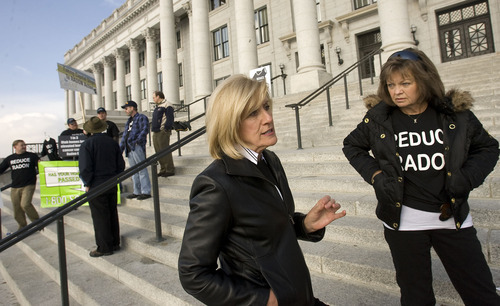This is an archived article that was published on sltrib.com in 2011, and information in the article may be outdated. It is provided only for personal research purposes and may not be reprinted.
About 10 people, clad in black T-shirts emblazoned with large, white radiation warning symbols across the back and "Reduce Radon" on the front, gathered for a noon rally on the state Capitol steps one day this week.
They hoped to raise awareness that undetected radon gas seeping from the ground into just about any home, can lead to lung cancer and death. But their paltry numbers reflect their frustration that the threat of the odorless, colorless radioactive gas isn't taken more seriously.
"Nationally, about 21,000 die from lung cancer from radon every year," state indoor radon coordinator Christine Keyser, said. "And about 3,000 die from second-hand smoke. But, what gets the most attention?
"And it's so preventable," she adds.
Many more Utahns are likely to be affected by radiation from radon gas in their homes, than from radioactive waste stored in the west desert, Keyser says.
According to the EPA, radon is the No. 1 cause of lung cancer among nonsmokers. For those who smoke, the risk rises exponentially. And since lung cancer is not easily detected early on, more than 85 percent of those who contract it die within five years. One of seven lung cancer deaths is caused by radon.
Utah Department of Environmental Quality tests show that up to 35 percent of homes tested fall at or above the EPA's "action level" of 4.0 picocuries per liter of air, the agency's recommended level for taking action to fix the problem.
Putting that number in perspective, an EPA brochure notes that radon exposure at that level carries the same risk, over a lifetime, as dying in a car crash.
And Utahns are at greater potential danger than much of the U.S., according to a color-coded map on the EPA's website. A finger of red — the hue designating the highest risk — pokes down from the northern Rockies into the heart of Utah, touching much of the eastern and central part of the state. The rest is highlighted orange.
A zip code matrix on the Utah Division of Radon Control's website is more detailed. With tests conducted in over 7,500 homes, Salt Lake County averaged 4.3 pCi/L per home, including 8.2 and 5.9 in two Sandy ZIP codes, one of the higher areas.
Averages can vary greatly from home to home, Keyser said.
"It can be found in a new home or an old home, a home on the east side or on the west side, a home with a basement or one without…every home should be tested."
For $6 the Utah Division of Radon Control offers test kits that can be ordered online at http://www.radon.utah.gov. But state officials are concerned that so few homeowners bother.
Laurel Longhurst, 56, a Sandy homemaker and mother of four, wishes she had known to test her home. In 2006 she went to her doctor for a sinus infection. As it turned out, that was a blessing, she says.
Given a routine test of lung capacity, she failed. Further examination showed a two-inch mass in her right lung. And it had spread across her chest to create a similar-sized mass in a lymph node. Her doctor classified the cancer late stage; by odds she had nine months to live.
Since she didn't smoke, her doctor fingered radon as the likely culprit.
And with the cancer already too close to her heart, surgery was out. Longhurst had to endure six months of painful chemotherapy and radiation treatments. Her petite, 5-foot two-inch frame withered to an emaciated 90 pounds.
Now, just months shy of her fifth anniversary, when she can be declared cancer-free, she says her oncology nurse recently confided that she knows only four other patients still alive with lung cancer as advanced as Longhurst's was.
She's soberly aware of what could have been. "I call it a mighty miracle — a total mighty miracle. I feel blessed to be alive." —
Radon: the homegrown killer
Radon's presence is rarely caused by pollutants, but occurs naturally, from the decay of small amounts of uranium found in nearly all rock and soil, according to the Division of Radiation Control. Normally, the radioactive gas would safely disperse in open air, but it collects in enclosed spaces such as houses, mostly at the lowest level.
Travis Jewell, a contractor specially licensed in radon mitigation, retrofits around 200 homes a year, he says, at a cost of about $1,200 to $1,600. But homeowners could save hundreds of dollars if builders followed radon-resistant construction techniques, he said.
Currently, the state lists only three builders that do.



